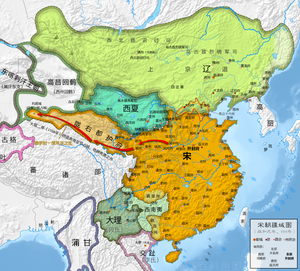Lý–Song War
| Lý–Song War | |||||||
|---|---|---|---|---|---|---|---|
 Map of the two dynasties, Song Dynasty in Orange, Lý Dynasty in Purple |
|||||||
|
|||||||
| Belligerents | |||||||
|
Song dynasty Khmer Empire Champa |
Đại Việt under the Lý dynasty | ||||||
| Commanders and leaders | |||||||
| Guo Kui (郭逵) Zhao Xie (趙禼) Zhang Shoujie (张守节) † Su Jian (苏缄) † |
Lý Thường Kiệt Nùng Tôn Đản Thân Cảnh Phúc Lưu Ưng Ký (POW) |
||||||
| Strength | |||||||
| Battle of Yongzhou: More than 2800 regular troops Song Counteroffensive: 300,000 regular troops and people |
Invasion of Guangxi: 80,000–100,000 troops During Song Counteroffensive: 60,000 (estimate) |
||||||
| Casualties and losses | |||||||
| At least 250,000–400,000 troops and civilians (including massacre of Yongzhou): More than half of Song troops died from disease during the counteroffensive against Lý | 20,000 in battle of Guangxi, casualties during Song Counteroffensive unknown | ||||||
Indecisive
The Lý–Song War was a significant war fought between the Lý dynasty of Đại Việt and the Song dynasty of China between 1075 and 1077. The war began in 1075 when the Lý emperor ordered a preemptive invasion of the Song dynasty using more than 100,000 soldiers, where Đại Việt's forces defeated the Song army and razed the city of Yongzhou (modern day Nanning) to the ground after a forty-two day siege. In response, in 1076 the Song led an army of over 300,000 to invade Đại Việt and by 1077 nearly reached Thăng Long, the capital of Đại Việt, before being halted by general Lý Thường Kiệt at the Nhu Nguyệt River in modern Bắc Ninh Province. After a long battle at the river with high casualties on both sides, Lý Thường Kiệt offered peace to the Song, and the Song commander Guo Kui agreed to withdraw his troops, ending the war.
Tension and border hostilities were already high in the years prior to the war; in the 1050s, Nùng Trí Cao, the head of the local Nùng people in Quảng Nguyên (now Cao Bằng Province) attempted to fight for independence and establish a frontier state for his people, but his rebellion was crushed by Song general Di Qing (1008–1061). While the Lý court did not intervene in the matter, the threat of Song expansion was always on the horizon due to increasing numbers of Han Chinese settlers, such as the soldiers from Di Qing's division and those north of the Yangzi River settled in areas that the Lý relied upon for the extraction of natural resources.
In 1075, Wang Anshi, the chancellor of the Song dynasty, told Emperor Shenzong (r. 1067–1085) that Đại Việt was being destroyed by Champa, with less than ten thousand soldiers surviving, so hence it would be a good occasion to annex Đại Việt. The Song emperor then mobilized his troops and passed a decree to forbid all the provinces of Song to trade with Đại Việt; this prompted the Lý court under Emperor Lý Nhân Tông (r. 1072–1127) to authorize a preemptive invasion of Guangxi in the Song dynasty. Lý Nhân Tông then sent general Lý Thường Kiệt and Nùng Tông Đán, a kinsman of the Nùng rebel Nùng Trí Cao, to lead more than a hundred thousand soldiers to invade the Chinese province of Guangxi.
...
Wikipedia
